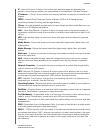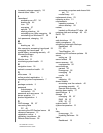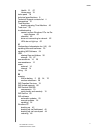
GLOSSARY
73
WD SENTINEL DX4000
ADMINISTRATOR’S GUIDE
IP—Internet Protocol. A system that controls how data messages are separated into
packets, routed from the sender, and reassembled at the destination. See also Protocol.
IP Address—A 32-bit, binary number that uniquely identifies a computer connected to the
Internet.
iSCSI —Internet Small Computer System Interface. iSCSI is an IP-based storage
networking standard for linking data storage facilities.
iTunes—An audio playback program used to import songs and other media files from your
hard drive or WD Sentinel server drive.
LAN— Local Area Network. A system in which computer users in the same company or
organization are linked to each other and often to centrally-stored collections of data in LAN
servers.
LED—Light-emitting Diode. An electronic device that lights up when electricity is passed
through it.
Media Server—Device that stores and shares media files (digital audio, digital video, and
digital photos).
Media Storage—Device that stores media files (digital audio, digital video, and digital
photos).
Multi-user—A system in information technology that enables more than one user to access
data at the same time.
NAS—Network Attached Storage. Hard disk storage that is set up with its own network
address rather than being attached to the computer that is serving network workstation
users.
Network Computer—A computer that communicates with a central data storage facility
such as a server or RAID system.
NFS—Network File System. A network file system protocol that allows a user on a client
computer to access files over a network as easily as if the network devices were attached to
its local disks. Normally associated with UNIX systems. See also Protocol.
NTP—Network Time Protocol. A protocol for synchronizing the clocks of computers and
equipment over a network. See also Protocol.
Operating System—Software that allows users and programs installed on your system to
communicate with computer hardware such as a hard drive.
Partition—A logical division on a hard drive that the operating system treats as a separate
hard drive. Each partition is assigned a unique drive letter.
Port (Hardware)—A specialized outlet on a device for connecting to other devices using a
cable or a plug. Ethernet ports, power ports, and USB ports are examples.
Protocol— A convention of data transmission that defines timing, control format, and data
representation.
RAID—Redundant Array of Independent Disks. A grouping of hard drives in a single system
to provide greater performance and data integrity.
RAID 1— RAID protocol in which two copies of the data are instantaneously recorded: each
on separate hard drives. RAID 1 ensures the protection of users' data because in the event
that one of the hard drives fails, the other hard drive(s) will continue to read and write data
until the faulty hard drive is replaced and rebuilt to once again safely mirror the data. See
also Mirroring.


















